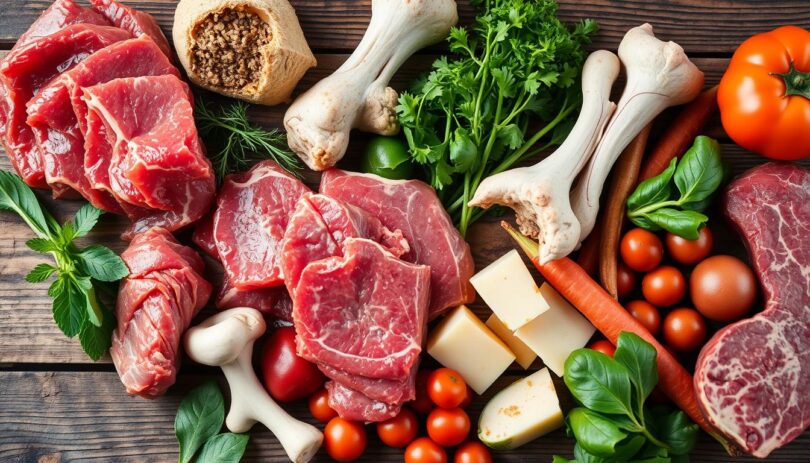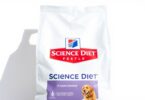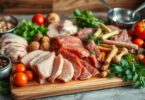Have you ever wondered if a raw diet could be the key to unlocking your dog's full health potential? In recent years, pet owners have increasingly turned to raw dog food, believing it offers a more natural approach to their pets' nutrition. But what exactly is raw dog food, and why is it gaining so much attention?
A raw diet typically consists of uncooked ingredients like meat, bones, and organs, mimicking what dogs might eat in the wild. This approach is often seen as a healthier alternative to traditional kibble. Studies suggest that raw-fed dogs may experience benefits such as improved coat condition, stronger immune systems, and better dental health. However, it's important to approach this diet with care to ensure it's balanced and safe for your pet.
In this comprehensive guide, we'll delve into the pros and cons of raw feeding, explore expert recommendations, and provide practical tips for transitioning your dog to a raw diet. Whether you're a curious newcomer or a seasoned raw feeder, this guide will serve as your one-stop resource for all things raw dog food.
Understanding the Raw Food Diet for Dogs
Exploring the concept of raw feeding can feel overwhelming, but it’s simpler than you might think. A raw food diet for dogs focuses on uncooked ingredients like meat, bones, and organs, aiming to mirror what dogs would naturally eat in the wild. This approach differs significantly from traditional processed pet food, which often contains fillers and preservatives.
Raw feeding has gained popularity as pet owners seek more natural nutrition for their pets. It emphasizes whole, unprocessed ingredients, which many believe are healthier for dogs. However, it's important to understand the nutritional aspects, such as lower carbohydrates and higher fat content compared to conventional diets.
Quality is key when it comes to raw pet food. Look for ingredients sourced from products fit for human consumption to ensure safety and nutritional value. Scientific insights suggest that while raw feeding can offer benefits like improved coat health and stronger immune systems, it also carries risks like bacterial contamination.
If you're wondering, “Is raw food good for dogs?” the answer depends on the quality and balance of the diet. Consulting with a veterinarian can help you make an informed decision tailored to your dog's needs.
Raw Food Diet for Dogs: An Introduction
Discover how a raw food diet can transform your dog's health. This approach focuses on serving uncooked ingredients like meat, bones, and organs, closely mimicking what dogs would naturally eat in the wild. The primary benefits include improved digestion and a stronger immune system.
Quality ingredients are crucial. Look for sources that are fit for human consumption to ensure safety and nutrition. Fresh components play a vital role in maintaining your dog's health. A balanced nutritional plan is essential, and experts often recommend consulting with a veterinarian to tailor the diet to your dog's specific needs.
Common ingredients include muscle meat, offal, and ground bones. Each serves a purpose, like providing essential amino acids or minerals. A balanced diet ensures your dog gets all necessary nutrients. While some owners prepare meals at home, commercial options offer convenience and consistency.
Whether you're new to raw feeding or looking to refine your approach, understanding the basics is key. With the right ingredients and proper balance, you can help your dog thrive on this natural path.
Key Benefits of a Raw Food Diet for Dogs
Transitioning your dog to a raw food diet can unlock a variety of health benefits that contribute to their overall well-being. From improved physical condition to increased energy levels, the advantages of this approach are both visible and impactful.
Improved Coat, Skin, and Dental Health
A raw diet rich in natural oils and nutrients can lead to a shinier, healthier coat and smoother skin. High-quality protein sources, such as muscle meat and organs, provide essential amino acids that strengthen dental health and muscle tone. Balanced nutrients play a crucial role in maintaining your dog's vitality and overall health.
Raw, meaty bones act as a natural toothbrush, helping to reduce plaque and improve breath. This approach not only enhances your dog's appearance but also supports their long-term health through a holistic diet.
Enhanced Energy and Mealtime Excitement
Dogs on a raw diet often exhibit increased energy levels and a heightened enthusiasm for mealtime. The natural appeal of unprocessed ingredients can make feeding more enjoyable and engaging for your pet. Many owners report observing these positive changes, which contribute to a more vibrant and active lifestyle for their dogs.
Comparing Raw Dog Food to Traditional Pet Diets
When evaluating options for your pet's nutrition, understanding the differences between raw dog food and conventional diets is crucial. Raw dog food focuses on unprocessed ingredients, while traditional diets often include cooked and processed elements.
Nutritional Differences Explained
Raw dog food typically includes whole meats, bones, and organs, providing natural fats and proteins. These components are often more easily absorbed by your pet's digestive system compared to processed ingredients found in traditional diets.
Traditional pet diets may contain fillers like grains or by-products, which can be harder for pets to digest. Raw options avoid these, offering a cleaner source of nutrition. The term “raw” indicates that ingredients haven't been cooked, preserving natural enzymes that might be lost in processing.
While traditional diets are convenient and cost-effective, raw dog food often provides higher-quality protein sources and fewer unnecessary additives. This can lead to improved digestion and overall health for your pet.
Health Improvements and Overall Pet Wellness
A raw diet can be a powerful way to support your pet's overall wellness. By focusing on unprocessed, high-quality ingredients, this approach often leads to noticeable improvements in your dog's health and vitality.
Strengthening the Immune System
One of the key advantages of a raw diet is its ability to bolster your pet's immune system. High-quality protein sources, such as meat and organs, provide essential nutrients that work together to support natural immune defenses. These nutrients help your pet's body fight off infections and recover more quickly from illness.
Studies and expert claims suggest that dogs on a raw diet often experience reduced allergy symptoms and faster recovery times. This is partly due to the absence of processed additives and fillers, which can sometimes trigger allergic reactions. A balanced intake of vitamins and minerals ensures your pet's immune system operates at its best.
Beyond immune support, a raw diet can also enhance your pet's energy levels and overall longevity. The natural, easily digestible ingredients ensure that your pet absorbs the maximum amount of nutrients, leading to a more vibrant and active lifestyle.
Addressing Safety and Proper Handling Tips
Ensuring your pet's safety while handling their meals is crucial. A raw pet diet requires careful attention to hygiene and storage to minimize potential risks. By following simple guidelines, you can create a safe environment for feeding your pet.
Best Practices for Storage and Hygiene
Proper storage is essential to maintain the quality and safety of raw pet meals. Use dedicated containers and immediately refrigerate any leftovers to prevent bacterial growth. Handling bone items safely is key—always store them separately to avoid accidental splintering.
Understanding High-Pressure Processing (HPP)
High-Pressure Processing is a method used to reduce pathogens in raw pet meals. This technique ensures safety without altering the natural composition of the ingredients. While HPP is effective, some pet owners prefer entirely unprocessed options, highlighting the importance of choice in feeding methods.
Hygiene routines should include washing hands and utensils thoroughly before and after handling raw meals. Keep raw items separate from other foods to prevent cross-contamination. Educating all family members on these practices ensures a safe feeding process for your pet.
By adhering to these safety measures, you can confidently feed your pet a raw diet while maintaining a clean and healthy environment. Always prioritize proper handling to make raw feeding a positive experience for both you and your pet.
Understanding Potential Risks and Concerns
While a raw diet offers several benefits, it's important to be aware of the potential risks. One of the main concerns is bacterial contamination, which can pose health risks for both pets and humans.
Bacterial Contamination and Food-Borne Illnesses
Studies have shown that raw pet food can contain harmful bacteria like Salmonella and Listeria. According to a study by the FDA Center for Veterinary Medicine, approximately 7.7% of raw pet food samples tested positive for Salmonella, while 16.3% were positive for Listeria monocytogenes. These pathogens can lead to food-borne illnesses in both animals and humans handling the food.
To mitigate these risks, proper handling and storage are crucial. Here are some strategies:
- Always store raw food in sealed containers and refrigerate leftovers promptly.
- Wash your hands thoroughly before and after handling raw food.
- Keep raw food separate from other foods to prevent cross-contamination.
By following these guidelines, you can reduce the potential hazards associated with a raw diet and ensure a safer feeding experience for both you and your pet.
Expert Insights on Mixing Raw Dog Food With Kibble
Mixing raw dog food with kibble can be a great way to introduce your pet to the benefits of raw feeding without a full commitment. Many pet owners choose this approach to gradually transition their pets or to add variety to their meals.
One of the main reasons owners opt for a mixed diet is to enjoy the best of both worlds. Kibble provides convenience and structure, while raw dog food adds natural nutrients and variety. This combination can enhance digestion and ensure a broader range of essential vitamins and minerals.
Experts suggest starting with small portions of raw pet food mixed into your dog's regular meals. A common recommendation is to begin with a 25% raw and 75% kibble ratio, adjusting gradually based on your dog's response. This method helps prevent digestive upset and allows your pet to acclimate smoothly.
Monitoring your dog's health during this transition is crucial. Look for signs like improved energy levels, shinier coats, or better digestion. If your pet shows discomfort or adverse reactions, consider slowing down the transition or consulting a veterinarian for personalized advice.
Remember, every dog is different. What works for one may not work for another. By listening to your pet's needs and following expert guidance, you can create a balanced and nutritious diet that supports their overall well-being.
Choosing the Right Raw Dog Food Options
Selecting the perfect raw dog food can feel like a daunting task, but with the right guidance, it becomes a straightforward process. The key lies in understanding what makes an ingredient list robust and how different meats can meet your dog's nutritional needs.
Assessing Quality Ingredients and Sourcing
When evaluating raw pet food, start by examining the ingredient list. Look for whole meats like beef or chicken, and ensure they are listed as the primary components. Avoid products with generic terms like “meat” without specifying the source. Trusted brands like Steve’s Real Food emphasize transparency, sourcing ingredients from human-grade suppliers to ensure safety and quality.
Evaluating Different Raw Meat Types
Choosing the right type of meat is crucial. Beef provides robust protein and iron, while chicken offers leaner protein and essential amino acids. Formulations that combine beef and chicken can offer a balanced mix of nutrients. Consider your dog's specific needs—active dogs might benefit from higher protein options, while less active dogs may require a more moderate balance.
When reviewing labels, seek certifications like “human-grade” or “organic” as indicators of quality. These marks ensure the ingredients meet high standards. Whether opting for commercial or homemade raw diets, prioritize freshness and ethical sourcing to provide your dog with the best possible nutrition.
How to Transition Your Dog to a Raw Food Diet
Switching your dog to a raw food diet can be an exciting step toward improving their health, but it requires careful planning. A gradual transition is essential to prevent digestive upset and ensure your dog adapts smoothly.
Steps for a Gradual Diet Change
The process typically lasts 1 to 2 weeks, but some dogs may need up to 6 months. Start by mixing a small portion of raw dog food with their current meals. A common approach is to begin with 25% raw and 75% traditional food, gradually increasing the raw proportion over time.
Monitor your dog's stool quality and overall health. If they show signs of digestive upset, slow down the transition. For sensitive dogs, a 1/8 ratio of new to old food may be better, increasing slowly.
Consulting with Your Veterinarian
Before starting, consult your vet to discuss your dog's health and any concerns. They can provide personalized advice and help you avoid potential issues. Regular check-ups during the transition ensure everything is going smoothly.
Every dog is different, so be patient and adjust as needed. With careful planning and professional guidance, your dog can thrive on their new diet.
Feeding Guidelines and Portion Control
Proper feeding is essential to ensure your dog thrives. The right portion sizes and feeding schedules can make a big difference in their health and energy levels.
Determining the Correct Amount for Different Life Stages
To determine the right amount, consider your dog's weight, age, and activity level. For adult dogs, a good starting point is 2-3% of their body weight in nutrient-rich meals per day. For example, a 50-pound dog might need 1 to 1.5 pounds daily.
Puppies need more nutrients for growth, typically 5-6% of their weight daily until maturity. Seniors may require less, focusing on nutrient density to support aging health needs.
Adjust portions based on your dog's condition. If they gain or lose weight, tweak the amount. Consistency is key for optimal health. Regular feeding schedules help maintain energy levels and digestion.
Homemade Raw Dog Food: Recipes and Preparation Tips
Preparing homemade raw meals for your pet can be a fun and rewarding experience. With the right ingredients and a little creativity, you can create nutrient-rich recipes that support your pet's health and vitality.
A simple yet balanced recipe might include 70% muscle meat, 10% raw bones, and 10% organs. For example, a recipe could feature ground beef, chicken necks, and beef liver. Eggs are a fantastic addition, offering essential vitamins and minerals that support skin and coat health.
When preparing homemade meals, always prioritize safe handling. Store ingredients in sealed containers and refrigerate leftovers promptly. Wash hands thoroughly before and after handling raw items to prevent cross-contamination.
Cost is another consideration. While sourcing high-quality protein can seem expensive, options like raw bones and organs are often more budget-friendly. Planning meals in advance can also help manage costs and ensure variety.
Remember, every pet is unique. Always tailor recipes to your pet's specific needs and consult with a veterinarian to ensure nutritional balance. With patience and practice, you can create delicious, healthy meals that your pet will love.
Debunking Common Myths and Misconceptions
When it comes to nutrition, misinformation can be a significant barrier to making informed decisions. Let’s explore some common myths about raw feeding and separate fact from fiction.
Myths Versus Scientific Facts
One widespread belief is that a raw diet is inherently dangerous due to bacterial contamination. While it’s true that raw ingredients can contain pathogens like Salmonella, studies show that healthy dogs have strong stomach acids that neutralize many harmful bacteria. Proper handling and storage can further mitigate these risks.
Another misconception is that raw feeding is too expensive. While high-quality ingredients may have a higher upfront cost, many pet owners find that the long-term health benefits, such as reduced vet bills, make it a cost-effective choice. Buying in bulk or sourcing ingredients locally can also help manage expenses.
Some people believe that raw bones are unsafe because they can splinter. However, this is more of a risk with cooked bones. Raw bones are generally softer and more digestible, making them a safer option when properly sized for your pet.
There’s also a myth that raw feeding causes aggression in pets. This claim is unsupported by scientific evidence. In fact, a properly balanced diet can address nutritional deficiencies, such as low tryptophan levels, that might contribute to behavioral issues.
Understanding the facts empowers you to make the best decisions for your pet’s health. Always consult credible sources and experts to ensure you’re providing the most balanced and nutritious diet possible.
Cost Considerations and Long-Term Value
When considering a switch to a raw pet food diet, it's important to evaluate both the immediate costs and the long-term financial benefits. While the initial investment in high-quality raw ingredients may seem higher, many pet owners find that the long-term savings and health improvements make it a worthwhile choice.
Budgeting and Long-Term Savings
Breaking down the costs, a raw diet typically includes expenses for fresh meats, bones, and organs. For example, a medium-sized dog might require around $2 to $3 per day, totaling approximately $60 to $90 per month. In comparison, high-end kibble can range from $1.30 to $2.02 per day, adding up to around $36 to $56 per month.
However, the long-term savings come into play with improved health. Dogs on raw diets often experience fewer vet visits due to better digestion, reduced allergies, and stronger immune systems. This can lead to significant savings over time, offsetting the initial higher costs of raw ingredients.
Budgeting tips include buying in bulk, planning meals in advance, and considering homemade recipes that balance cost and nutrition. For instance, a homemade diet can cost as low as $2.48 per day, while premade options might range from $9 to $14.73 daily, depending on the brand and quality.
Ultimately, while the upfront cost of a raw diet may seem daunting, the combination of immediate health benefits and long-term savings makes it a cost-effective choice for many pet owners.
Communicating with Your Vet About Raw Feeding
Discussing your dog's nutrition with your vet can be a crucial step in ensuring their health. To make the most of your consultation, it's important to approach the conversation with confidence and clarity.
Effective Communication Strategies
Start by preparing for your vet visit. Gather information about your dog's current diet and any research you've done on raw feeding. This will help you discuss your concerns and questions more effectively.
When discussing raw feeding, be open and honest with your vet. Share your reasons for considering this diet and ask for their professional opinion. For example, you might ask, “What are your thoughts on raw feeding for my dog?” or “Do you recommend any specific raw feeding options?”
Your vet can provide tailored recommendations based on your dog's health, age, and lifestyle. They can also help you monitor your dog's progress and address any potential issues early on.
Effective communication is key to ensuring a successful transition to raw feeding. By working together with your vet, you can create a nutrition plan that supports your dog's overall well-being.
Final Takeaways and Next Steps for a Healthy Pet
As you conclude this journey through the world of natural pet nutrition, remember that every decision you make contributes to your pet's quality of life. Whether you're considering a full transition or a partial shift, the principles discussed here provide a clear roadmap to a healthier, more vibrant pet.
Your next steps could be as simple as consulting with a trusted vet or exploring community forums where pet owners share their experiences. Engaging with “dog cat” communities can offer valuable insights and support, helping you navigate this new path with confidence.
While this guide focuses on dogs, many of these principles can inspire “cat” owners as well. Every “number” and detail shared is designed to ensure a safe, balanced, and sustainable approach to your pet's nutrition. By taking these steps, you're not just feeding your pet—you're investing in their long-term wellness and happiness.
Empowered with knowledge, you're ready to make informed choices that will positively impact your pet's life for years to come. Keep learning, growing, and nurturing that special bond with your furry friend.







Leave a Comment